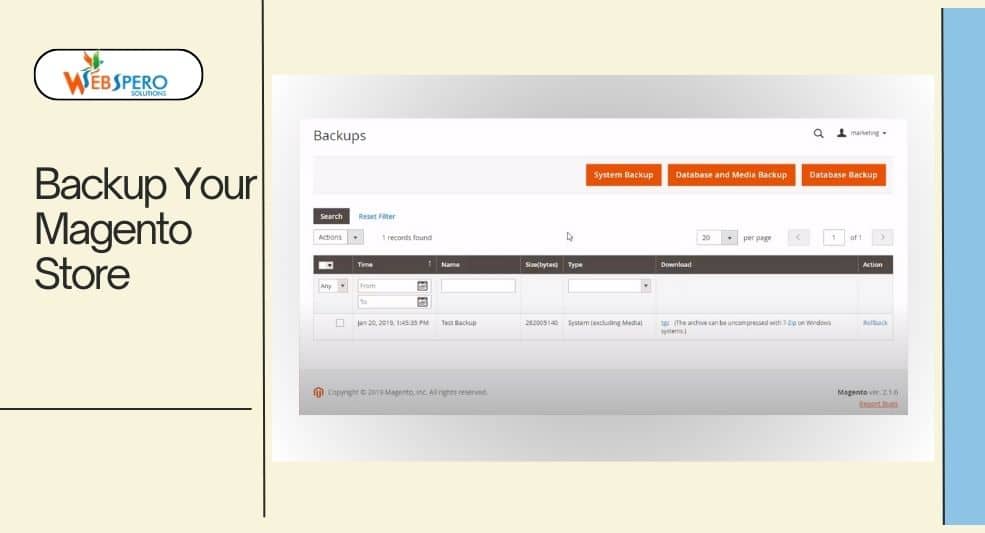Presently, there are over 130,000 live Magento websites; however, this number appears minuscule compared to 4.4 million live Shopify stores globally.
While both Magento and Shopify work similarly, the ease of use and eCommerce expertise of the latter is one of the many reasons why business owners migrate from Magento to Shopify.
While the migration might seem complex at the beginning, we are here to help you make this process smooth and easy.
Differences Between Magento and Shopify
Magento and Shopify are both eCommerce platforms; however, each provides different functionality and user experience.
One of the key differences among them is that Magento is an open-source platform written in PHP, meaning you need to handle hosting, maintenance, and security on your own. On the other hand, Shopify provides full hosting services and support. Also, it is written in different languages, including Ruby, Liquid, JavaScript, Rust, and WebAssembly.
Why Switch from Magento to Shopify?
From an eCommerce standpoint, Magento to Shopify migration offers a lot of benefits. Here’s all of them:

Budget-Friendly
Although Magento is free, thanks to being open-source, the running costs can quickly increase as you’ve to pay for hosting, security, and delivery on your own. If you opt for Magento Commerce (Adobe Commerce), the paid version, it can become significantly more expensive. On the other hand, Shopify, despite being a subscription-based service, is comparatively budget-friendly.
Ease of Use
Yes, Magento is more customizable; however, it requires technical expertise and even the assistance of a developer at times to make full use of it. Shopify is far easier to use and offers a more seamless experience.
Scalability
Shopify also provides a lot of features and plans to cater for all types of expansions. So, as your online store expands, you can easily add more functionality and support without a major overhaul.
Apps and Extensions
Shopify provides a wide range of apps and extensions that are easy to install and integrate seamlessly without requiring any coding.
Dedicated Support
Magento open-source doesn’t have an official support team, and Magento Commerce does have customer support but at a very high rate. Whereas Shopify offers dedicated customer support across all of their plans.
Hosting and Security
With Magento, you’re responsible for finding a hosting provider, managing server updates, and ensuring security; however, Shopify is a fully hosted platform that offers all the services. It also provides security benefits as well, including SSL certificates, PCI compliance for secure payments, and regular backups
What Data Can Be Migrated From Magento to Shopify
During the migration process, you can transfer the following data:
- Products (including all details)
- Customer database
- Order history
- Categories
- Coupons and Discounts
- Reviews
- URLs and SEO Data
- Blog posts
- Pages
- Shipping
- Taxes
- Images and media
Considerations Before Switching to Shopify
Before you begin migrating your online store to Shopify, thorough preparation is crucial. Here are important considerations:
Data Security
Security and privacy concerns are important to consider during migration. While sensitive data, such as customer information and payment details, must be handled carefully, it’s important to note that customer passwords and payment gateway information cannot be migrated directly due to encryption and security protocols.
Cost and Plans
If you are migrating from open-source Magento site, then, Shopify’s subscription-based services might add to your operational costs. So, carefully choose the plan that works well within your budget.
Browser Compatibility
Migration may not always translate to your website working perfectly on every internet browser. This can result in storefront functions not working properly in different web browsers.
Step-by-Step Guide to Migrating Your Site From Magento to Shopify
Setup Shopify Account

To get started, simply visit the official Shopify website and click on Start free trial. Then, add your details (store name, email address, and password) and complete the registration process.
Select a Plan
Simply choose the plan that aligns with your business needs and provide the billing details to activate your plan.
Choose a Shopify Theme

To select a theme similar to your old Magento store theme, go to the Shopify Admin Panel, click on Online Store, and select Themes.
Choose a theme and click on Install to apply it.
To make the theme appear just like your previous online store, access the Theme Editor. Make appropriate changes and apply the new theme.
Backup Your Magento Store

Creating a backup of your online store is very important to ensure you have a safety blanket in case something goes wrong during the migration.
To backup your Magento store, go to the Admin side panel, then click on System. From there navigate to Tools, then Backup.
With Magento you have the ability to create different types of backup.
System Backup: Create a complete backup of your entire database and file system.
Database and Media Backup: This includes customer info, product images, videos and more.
Database Backup: This is simply a backup of your database.
| NOTE: Some hosting providers offer automatic backups. In this case, you don’t need to create a separate backup. |
Transfer Data and Content
Transfering your entire online store is the most time-consuming part. Also, do not rush this process, as it can lead to errors, which can cost time and money to your business.
Download the Import Store App
While you can import some elements like products directly from your Magento store, for error-free and complete migration, you need to install one of the Import Store applications. You can select the one that works best for you; however, we recommend Matrixify, it allows you to bulk import and export your database. Please note that this is a paid app.
To download and install the app, go to the Shopify App Store, search for Matrixify, and click on Install.
Export Data from Magento

The next step is to export your data, including customer database, products, URLs, blogs, and more, to Shopify from Magento. Thankfully, Magento offers the bulk export option.
To do so, click on System on the Admin sidebar. From there, click on Data Transfer and Export.
Here, you can select Entity Type as products, customer main file, or customer addresses.
Since you’ve already installed Matrixify, you can export the data in XML format.
However, if you wish to import the data manually, you can export the data in CSV format.
| NOTE: You will need to repeat the process for products, customer main file, and customer addresses separately. |
Import Data into Shopify

After successfully importing the data, it is time to import it to your Shopify site.
To import the data, visit the Shopify admin page, then click on Apps and select Matrixify.
Here, select Magento from the drop-down menu.
Then go to Upload Files and click on Add File. Select the XML file exported from Magento.
Then click Continue import.
| NOTE: Make sure that your Magento database is error-free before importing. Otherwise, it will corrupt the files or import previous errors to Shopify. |
Redirect Magento URLs to Shopify
After importing the data, the biggest question is, “How to redirect Magento URLs to Shopify?”
It is also very important to set up 301 redirects to ensure that traffic going to your old Joomla website is redirected to the new Shopify site. Luckily, Matrixify will also help you with URL redirects.
But before you can redirect, you will need to obtain a complete list of URLs and then provide a new redirect list. This process can be very time-consuming, therefore, it is recommended to use web crawlers like Screaming Frog’s SEO Spider.
Next, create a spreadsheet with old and new URLs.
| NOTE: Make sure you are using the main, canonical version of the URL to avoid confusing search engines. |
Now, use Matrixify’s Import Section to update the URLs in Shopify.
| NOTE: This method can be used to update handles of Smart Collections, Custom Collections, Customer emails, and any other field or combination of fields. |
Post-Migration Checklist
Once the migration is complete, there are certain aspects you should go through to ensure that your new Shopify site is error-free and performs optimally.
Test Website Functionality
Even a smooth migration will not translate to everything working just the way you want on your new online store. Therefore, thoroughly check your website for any functional and structural issues. Go through forms, navigation menu, internal links, and sliders.
SEO and Analytics Setup
The migration process tends to impact your SEO score. So make sure that all your meta titles, descriptions, and alt texts have been correctly transferred and are optimized for search engines. Also, reconfigure Google Analytics, Google Search Consoles, and any other tracking tools to monitor the traffic and performance of your new Shopify store.
Optimize Site Speed
Performance is crucial for a seamless user experience, so make sure your website is loading pages quickly. If you notice any performance issues, you need to optimize your online store. You can also opt for professional Shopify Development Services to boost your website’s performance.
Security Measures
Shopify offers better security than Magento; however, you have to ensure those security measures are set up properly. Also, add multi-factor authentication (MFA) and back up your website regularly.
Common Migration Issues and How to Fix Them
Here are some common issues you can encounter when migrating from Magento to Shopify:
Missing Content
Data loss is one of the biggest challenges of store migration. While Matrixify would help you transfer products and customers easily, certain elements like orders may not transfer or transfer incorrectly.
To fix this, use Cart2Cart or Shopify’s Import Store feature to move your data.
Broken Links
Each eCommerce platform has a different URL structure, and this is also the case with Magento and Shopify. Thankfully, 301 redirects will fix any broken links issues.
Design Discrepancies
Different design elements and frameworks may not move. However, if you have selected a theme for Shopify, then you won’t have to worry about this part.
SEO Impact
As mentioned above, SEO ranking can be affected negatively by the migration. That is the reason why you need to perform SEO and analytics set up right after the migration.
If you notice a low ranking, recheck your SEO setting and submit a new sitemap to Google. You can also consult a Shopify expert.
Wrapping It Up
Although Magento to Shopify migration is a complex and time-consuming process, it is very much worth it. This is because it offers better eCommerce experience, updates, and security.
Just to recap, here’s a summary of the migration process:
- Setup Your New Shopify Account
- Install a new Shopify theme
- Create a backup of your Magento store
- Transfer data and content
- Redirect URLs
- Perform post-migration check
Frequently Asked Questions (FAQs)
How do you import products from Magento to Shopify?
Importing products to Shopify is very easy, thanks to Shopify’s native product import feature. Simply follow these steps:
- Prepare a CSV File: Ensure your product data (e.g., images, prices, descriptions, SKUs) is in a CSV format.
- Match Shopify’s Format: Adjust the data from Magento to fit Shopify’s required CSV structure. Shopify provides a guide for this.
- Upload to Shopify: Use Shopify’s product import feature to upload the CSV.
- Verify Import: Shopify will send a confirmation email when the process is complete.
How do you import collections & categories from Magento to Shopify?
Unfortunately, Shopify doesn’t natively support importing of collections & categories. However, you can work around it this way:
- Use Product Import: Add collections via products. This way, Shopify can auto-create collections based on product tags during import.
- Manual Setup: For a few collections, manually create collections in the Shopify admin.
- Automated Collections: Use tags like “Men’s Shoes” for automatic collection creation.
- Third-Party Apps: For large numbers of collections, use migration apps to save time and reduce errors.
How do you import blogs & pages from Magento to Shopify?
Similar to collections & categories, you cannot directly import blogs and pages. However, you can import blogs and pages with third-party apps like Matrixify.
How do you import customers from Magento to Shopify?
Thankfully, Shopify allows customers to be directly imported. But please note that you cannot import passwords because they’re encrypted.
So, after importing customers, you’d need to ask customers to reset their passwords.
To send reset invites, you can use the Bulk Inviter app (for Shopify Plus only).
How do you import orders from Magento to Shopify?
Once again, Shopify doesn’t support direct import of orders; however, you can use Matrixify to carry out this process.
Why do I need to import orders from Magento to Shopify?
It is important to import orders because these show order history to you and your customers.
How do you import discounts from Magento to Shopify?
You cannot directly import discounts, but you can use Matrixify to import discounts. Here’s a guide.
Are there any risks to migrating your online store from Magento to Shopify?
Yes, there is always risk involved in migration processes. However, with proper backup and migration tools, you can minimize the risk of data loss.
